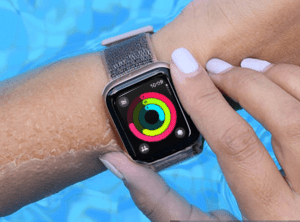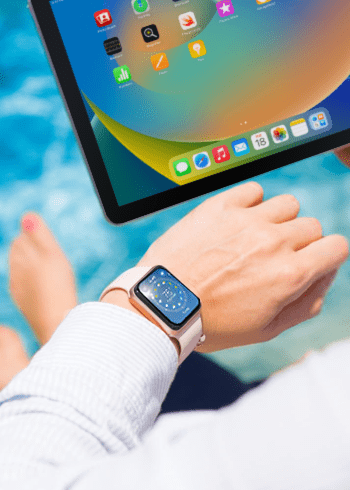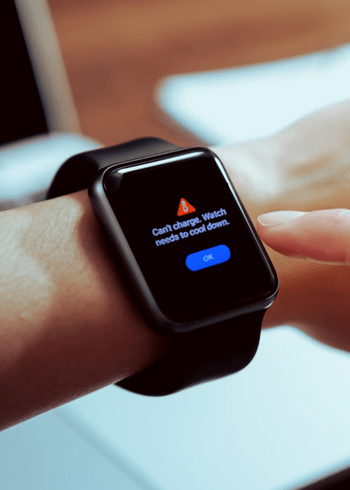Register
Worth Ave. Group - Providing peace of mind to consumers for over 50 years.
Keep Your Apple Watch Safe During Summer Activities
Posted:
June 24, 2024
Categories:
General


When summer rolls around, many of us can't wait to hit the beach or pool, often bringing along our favorite devices. While your Apple Watch is a fantastic companion for tracking workouts and keeping you connected, this sleek gadget needs a bit of extra care when exposed to water, sand, or direct sunlight on those hot summer days.
To help you keep your Apple Watch safe during your summer adventures, we'll answer some of your most common questions about what you can do with it (and what you should avoid) and share some tips on protecting it or resolving any issues you might face.

Can I swim with my Apple Watch?
Apple Watches from Series 2 onwards are water-resistant up to 50 meters depth. So, unless you have a Series 1, you can wear your Apple Watch while swimming in a pool or ocean. However, when it comes to scuba diving, water skiing, or similar water adventures involving deep submersion or high-velocity water, you should know that only the Apple Watch Ultra or later has enough water resistance to handle such activities. Also, remember that water resistance is not permanent, so its effectiveness might reduce over time.
Note: Be careful with sunscreen. When applying sunscreen at the beach or pool, avoid getting it directly on your watch. Sunscreen can affect the water resistance of your Apple Watch. If your gadget comes in contact with sunscreen, rinse it with fresh, lukewarm water and dry it with a lint-free cloth.
Are all Apple Watch bands suitable for water activities?
Not all Apple Watch bands are water-resistant. For instance, stainless steel and leather bands are unsuitable for prolonged water exposure as they can degrade or rust. If you want to take your Apple Watch swimming, opt for bands made from silicone or nylon. These materials are more resistant to water and easier to clean. Sport and loop bands are excellent choices for summer activities due to their durability and water resistance.

What should I do if my Apple Watch gets wet inside?
If you suspect that water has gotten inside your Apple Watch, turn it off immediately. Gently wipe it with a soft, lint-free cloth and leave to air dry. Do not use compressed air or external heat sources like hair dryers. Also, avoid inserting anything into the openings, like in the microphone or speaker ports, as this might damage your watch. Do not try to charge it or turn it on until you are sure it is completely dry. If this doesn't resolve the issue, your safest bet is to seek professional help.
How to turn on and off the Water Lock on an Apple Watch?
Before swimming or engaging in other water activities, you can activate the Water Lock feature to prevent accidental taps on the screen. This feature locks the screen and, upon turning it off, ejects any water from the speaker ports.
• To turn Water Lock on, swipe up on the watch face to access the Control Center and tap the water drop icon.
• After finishing your water activity, press and hold the Digital Crown to unlock the screen and eject any water that might be in the speaker.

Should I clean my Apple Watch after exposure to saltwater or chlorine?
After swimming, especially in saltwater or chlorinated pools, it's a good idea to clean your Apple Watch to remove any residue that might corrode the device or affect its performance. Start by turning off your watch and removing the bands. Then rinse it under lightly running, lukewarm, fresh water to remove any debris, sand, salt, or chlorine residues. Use a soft, lint-free cloth to gently wipe the watch, paying attention to the crevices around the digital crown and sensors. Do not use soaps, cleaning products, or abrasive materials, as they can damage the watch's finish or seals.
Can I wear my Apple Watch in hot tubs or saunas?
Apple advises against wearing your watch in environments where it could be exposed to extreme temperatures or steam, such as hot tubs or saunas. High temperatures and steam can affect the water-resistance seals and damage internal components. If you plan to use a hot tub or sauna, it's best to remove your Apple Watch to avoid any potential damage and ensure it remains in good working condition.
What should I do if my Apple Watch overheats?
Your Apple Watch can overheat if exposed to direct sunlight for too long, so avoid leaving or charging it in hot environments. Extreme heat and direct sun exposure can also affect your watch's battery life and performance or cause other damage. If your Apple Watch gets too hot, you'll see only a red thermometer and the time on the display. In this case, take off your watch from your wrist, place it in a cooler, shaded place, and allow it to cool down naturally. Avoid using water or cooling devices directly on the watch. Let it cool completely before turning it back on or resuming use.
By understanding the capabilities of your Apple Watch and knowing how to take good care of it, you’re on the right track to keeping your wearable gadget safe and functional. What else can you do to protect your Apple Watch from unexpected accidents and damages? You can get comprehensive Apple Watch Insurance covering a range of incidents, including accidental damage and theft!
Whether it’s a cracked screen from a sudden drop, water damage after a swim, or theft from your bag at the beach, our Apple Watch Insurance can provide the protection you need. See how Apple Watch Insurance can save you hundreds on repairs & replacements when accidents happen and get a free quote!















